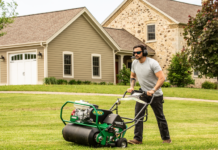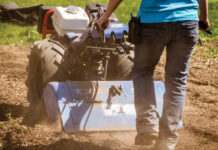By Aaron Pettit
The management of turfgrass in cemeteries is unique and requires an understanding of factors not seen in other turfgrass installations. These factors can include: underground vaults or liners; disturbed uniformed soil profiles; fill soil differences; extreme compaction and various compaction regions; rapid changes in landscape grades (which can add beauty and hide unwanted views); intensive equipment operations; and limited operation movement space. Together, these challenges can hinder proper turfgrass establishment and sustainability.
Soil Compaction
In cemeteries, people have placed their loved ones in the same soil being managed for turf and the landscape generally never changes once burials and headstone are placed. As a result, soil compaction from multiple factors can be a major challenge with turf establishment and sustainability. Compaction can lead to poor root growth by destroying soil structure and cutting soil pore space. This decreases the survivability of turf by reducing: available water, soil oxygen, percolation rate (causing surface ponding for days or weeks after substantial rain fall), and nutrient uptake.
Cemetery soil compaction can be found in both the surface soil and subsoil. Surface soil compaction can be very noticeable in cemeteries due to substantial equipment operations occurring over restricted and limited areas of movement. Normal cemetery layout and cemetery landscape design requires all equipment (mowers, ATV or UTV, haulers, excavators, etc.) be directed into highly trafficked corridors in and around grave markers, trees, plot markers, and monuments. Compaction from equipment causes rutting (uneven ground); resulting in poor aesthetics by lifting ground around headstones (results in turf scalping), discoloration patterns, and water ponding.

Subsoil compaction usually happens during grave filling with heavy soil tamping of fill soil at burial sites or from construction methods used during the establishment of burial areas. This subsoil compaction is usually less noticeable and often happens in layers as graves are compacted by tamping. The main effect of subsoil compaction in cemeteries is poor percolation leading to standing surface water and very muggy soils. Heavily saturated soils can lead to nitrogen loss, disease outbreaks, and low soil air levels which causes root issues. Also, layers formed by tamping of graves can give rise to air voids, or pockets. These pockets can fill with water and often collapse from the weight, causing gravesites to sink, and creating large ruts or depressed areas.
With ideal weather conditions, turfgrass in compacted soils may perform adequately despite having the root system confined to the shallow upper one or two inches of soil. However, routine stress — especially drought — will quickly damage or kill the turf. Unfortunately, soil compaction is necessary for cemetery operations since it is used to prevent or reduce soil settling of gravesites, provide firm ground for people and equipment, and ensure stability for headstone markers.

Soil Qualities
Soil texture and structure can also be associated with turfgrass difficulties. Cemetery soils are usually a mixture of soil layers or horizons (majority B and/or C horizon). A great number of cemeteries are established on land which has been repurposed from its original use; this includes removal of structures, burying debris, stripping topsoil, regrading, and using foreign material as fill. Also, soil removed at the burial site is usually not the same soil used to fill the burial site. This fill soil usually comes from another area in the cemetery or is brought in from outside sources. This causes uneven soil characteristics throughout the cemetery. Most soil used in filling grave sites has no natural structure (high level of saprolite), contains little or no fertility, includes variable soil pH levels, and can have high clay content. These issues can reduce the soils’ natural ability to filter water and lead to unbalanced soil fertility and chemistry; resulting in uneven turfgrass growth, patchy discoloration, and/or necrosis.
Solutions
To reduce problematic soil issues in cemeteries, start by limiting the compaction in construction and burial sites that would affect turfgrass performance and survivability. For example, compact soil to 85% of maximum density or don’t exceed 1.6 g cm-3 bulk density. This method, however, requires costly testing and can only be used for large areas of construction and not for individual gravesites. A better method is to instruct cemetery employees in filling and tamping graves more frequently, but less aggressively. Also ensure no compaction, besides a turf roller, occurs in the top six to 10 inches of soil. There should also be good practices in place to alleviate soil compaction and rutting over time such as: direct hollow tine core aeration, slice aeration, shatter/aerovation, and topdressing. Reducing traffic or using lighter impact equipment in daily operations can also help. If required in exceedingly bad conditions, renovate the section with deep tillage and grading.
Cemeteries should also ensure proper soil installation during cemetery construction and burial. The soil profile needs to be uniform throughout the site for easy and proper management. The top six to 10 inches of soil should be an enhanced soil for optimal turf root growth; this could be a modified fill soil, imported topsoil (compatible to subsoil), or engineered soil. Use of compost for modifying existing soils can be beneficial, however, ensure the compost is good quality for turf growth. Compost can create problems if it: is not properly matured; contains a high calcium carbonate equivalence (lime affect); has a low moisture or high salt content; and does not mix well. Always consult an expert when using compost and mix it with soil at proper ratios.
When dealing with engineered soil in cemeteries, note that most of these soils have been created for open, level, easily drained areas with heavy traffic (athletics fields, golf courses, etc.) and have not been widely used in cemeteries. These soils are generally very coarse sand amended with organic matter, which can resist compaction but can also reduce the water hold capacity. This can require increased irrigation and nutrient management depending on the binding of materials. Engineered soils are costly and must be removed separately from fill soil when excavating burials; this soil will not match surrounding native soil properties and are not recommended unless used uniformly throughout the cemetery.(Patches would cause varying turf color and improper drainage). However, over crypt fields with set soil depth of 16 to 24 inches, the use of engineered soil may be ideal.
 Pettit is an agronomist with the U.S. Department of Agriculture (USDA) in Arkansas and a former agronomist/soil scientist with Arlington National Cemetery and Columbia Garden Cemetery in VA.
Pettit is an agronomist with the U.S. Department of Agriculture (USDA) in Arkansas and a former agronomist/soil scientist with Arlington National Cemetery and Columbia Garden Cemetery in VA.











![[VIDEO] Dickies®: Discover Workwear That’s Anything But Uniform](https://turfmagazine.com/wp-content/uploads/2023/06/1647663814-4b1a2a7742790a9b1e97a3b963477850192e1d6a9dfba9b07214a77bae25d6e3-d-218x150.jpg)




























![[VIDEO] Dickies®: Discover Workwear That’s Anything But Uniform](https://turfmagazine.com/wp-content/uploads/2023/06/1647663814-4b1a2a7742790a9b1e97a3b963477850192e1d6a9dfba9b07214a77bae25d6e3-d-324x160.jpg)